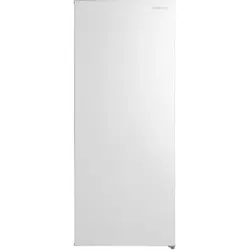Documents: Go to download!
User Manual
- User Manual - (English)
- Guides & Manuals - (French)
- warranty - (English)
- marketing sheet - (English)
- Features
- Setting up your freezer
- Using your freezer
- Maintaining your freezer
- Troubleshooting
Table of contents
USER GUIDEUpright Freezer
Features
Package contents
- 7 Cu. Ft. Upright Freezer
- Accessory bag with hardware for reversing the door
- User Guide
Dimensions
Note: The illustrations shown in this User Guide are for reference only. The actual product may differ slightly.
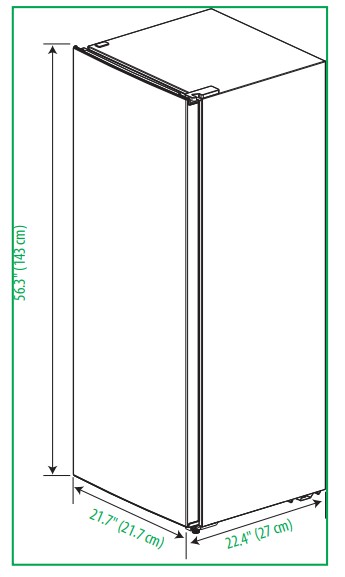
Components
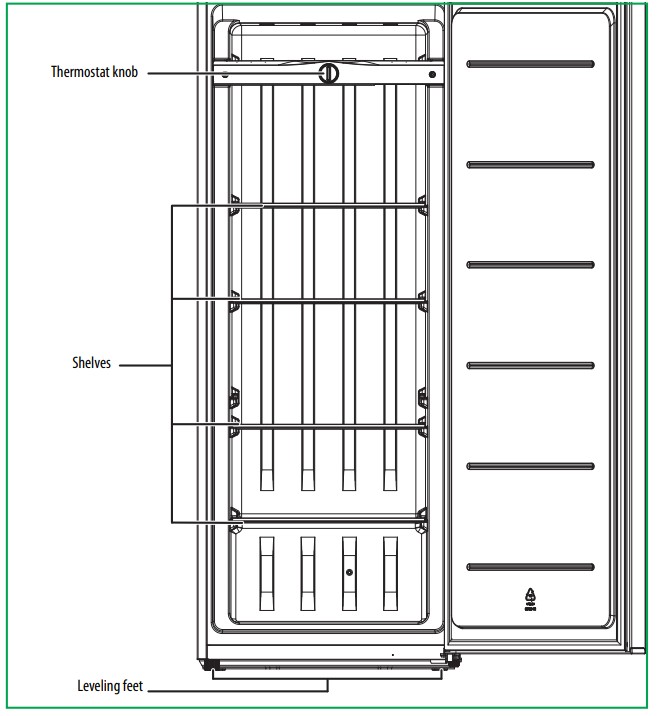
Thermostat knob
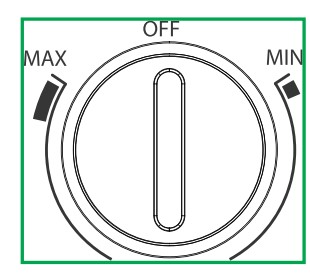
| ITEM | FUNCTION |
| Thermostat knob | Turn the knob to adjust the temperature. MIN is the warmest temperature. MAX is the coldest temperature. The temperature range is 10.4°F to -11.2°F (-12°C to -24°C). Turn to the OFF position to turn your freezer off |
Setting up your freezer
- Before using your freezer, remove the exterior and interior packing including the bottom cushions, foam pads, and tape inside your freezer. Remove the plastic film from the door and sides.
- Let your freezer stand upright for more than 30 minutes before connecting it to power. This reduces the possibility of a malfunction in the cooling system from incorrect handling during transportation.
- Before putting any fresh or frozen foods in your freezer, let your freezer run for two to three hours. If the ambient temperature is high, for example in summer, wait for four or more hours.
- Wash the inside with a damp, warm cloth and a baking soda solution (two tablespoons in a quart of water), then wipe dry with a dry cloth. Do this periodically to keep your freezer looking new.
- For correct operation, you should level your freezer using the leveling feet. If you do not level your freezer, the door may not close or seal correctly, causing cooling, frost, and moisture problems. See Leveling your freezer on page 14.
- When moving your freezer, do not tilt it beyond 45° from upright.
Finding a suitable location
- Place your freezer on a floor that is strong enough to support your freezer when it is fully loaded.
- Do not install your freezer on carpeting or a rug.
- Your freezer is designed to be free-standing and should not be recessed or built-in.
- If you use your freezer in a garage, make sure that the ambient temperature is between 5°F and 109°F (-15°C and 43°C).
- Allow 4 inches (10 cm) of space between the sides of your freezer and the surrounding walls, 4 inches (10 cm) between the back of your freezer and the wall, and 11.8 inches (30 cm) between the top of your freezer and the ceiling.
- This allows for correct air ventilation. Adjust the feet to keep your freezer level.
- See Leveling your freezer on page 14.
- Position your freezer away from direct sunlight and sources of heat, such as a stove, heater, or radiator. Direct sunlight may affect the acrylic coating and heat sources may increase electrical consumption. Extremely cold temperatures may also prevent your freezer from performing correctly.
- Avoid locating your freezer in moist areas.
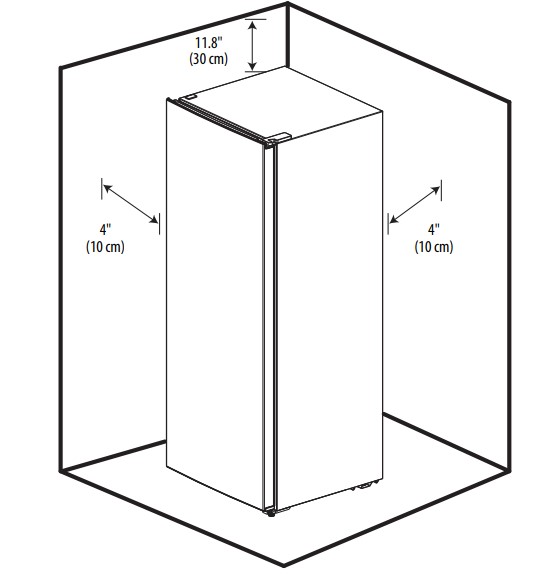
- If you locate your freezer next to a fixed wall, allow sufficient space on the hinge side for the door to swing open.
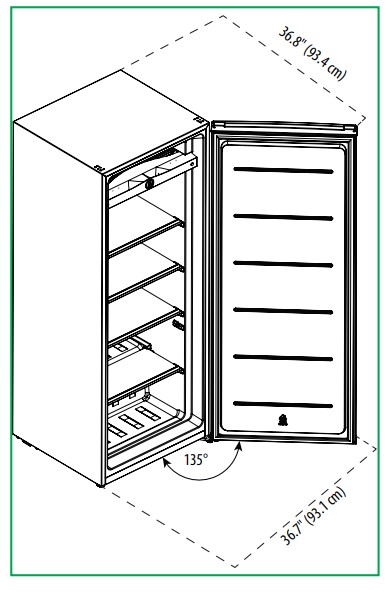
Leveling your freezer
If you do not level your freezer during installation, the doors may not close or seal correctly which can cause cooling, frost, or moisture problems.
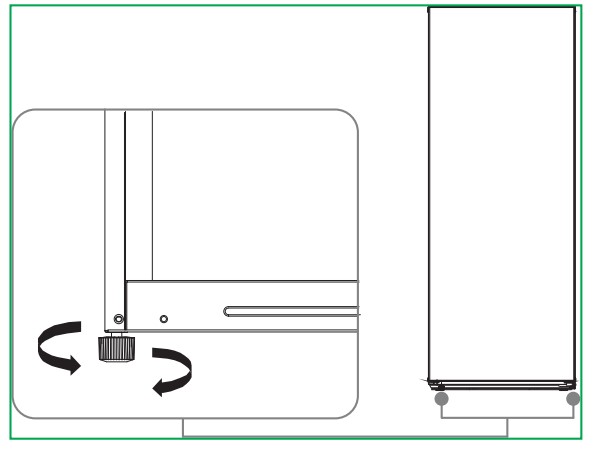
- To level your freezer, rotate the leveling feet clockwise (to raise) your freezer or counter-clockwise (to lower).
Note: To make it easier to adjust the feet, have someone push against the top of your freezer to tilt it slightly
Reversing the door
WARNINGS:
- Unplug your freezer before you reverse the door. Failure to unplug your freezer may result in serious injury or death from electrical shock.
- To avoid personal injury and property damage, get another person to help you reverse the door.
Note: The illustrations shown in this section are only for reference. The actual product may differ slightly.
You need the following tools to reverse the freezer door:

- Unplug the power cord and remove all food from your freezer.
- Tape the freezer door shut

- Remove the left hinge hole cap. Remove the upper-right hinge cover, the hinge screws, then remove the top hinge.
CAUTION: Make sure that you keep the door vertical while you remove the hinge to avoid damaging the hinge or the door.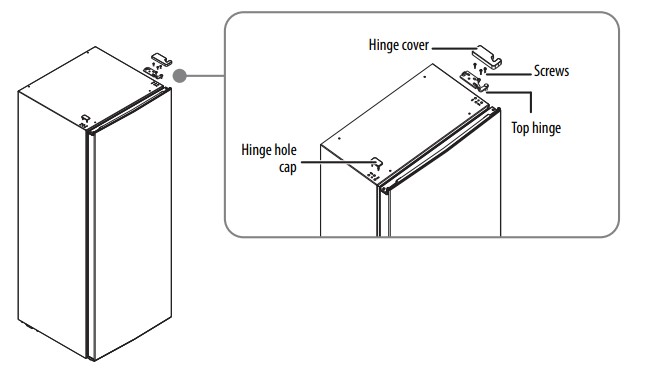
- Remove the tape, then remove the door.
Remove the door stopper screw and the door stopper, then install the stopper on the other side of the door.
Unscrew and remove the leveling foot. Remove the hinge screws, then remove the bottom hinge.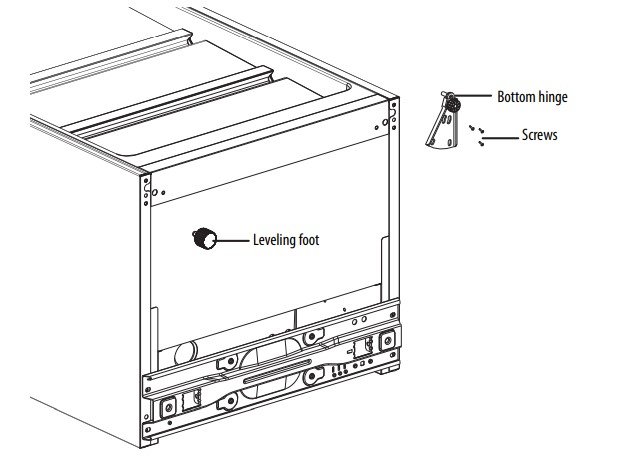
Install the leveling foot on the right side and the bottom hinge on the left side.
With your freezer upright, lower the door on the bottom hinge. Make sure that the door gasket fits tightly.
Remove the top left hinge and hinge cover from the accessory bag.
Secure the top hinge with the three screws you removed earlier, then install the hinge cover. Install the hinge hole cap on the right side.
Grounding requirement
Your freezer must be grounded. Your freezer is equipped with a cord having a grounding wire with a grounding plug. The plug must be inserted into an outlet that is correctly installed and grounded.
Consult a qualified electrician or service person if you do not completely understand the grounding instructions, or if you think your freezer may not be correctly grounded.
WARNINGS:
- Incorrect use of the grounding plug can result in a risk of electric shock.
- Do not, under any circumstances, cut or remove the third ground prong from the supplied power cord.
Connecting to power
- Plug your freezer into a dedicated, correctly installed, grounded wall outlet.
- Use a separate electrical circuit from other operating appliances. Do not under any circumstances cut or remove the third (ground) prong from the power cord. If you have questions about power or grounding contact a certified electrician or an authorized service center.
- Plug in and run your freezer for two to three hours before making any temperature adjustments and before adding food. This lets your freezer reach a stable temperature.
Notes:
- Check your local power source. Your freezer requires a 110V-120V, 60 Hz power supply.
- Use a receptacle that accepts the grounding prong. The power cord is equipped with a 3-prong (grounding) plug which mates with a standard prong (grounding) wall outlet to minimize the possibility of electric shock hazard from your freezer.
- Do not use an extension cord with your freezer. If the power cord is too short, have a qualified electrician install an outlet near your freezer. Use of an extension cord can negatively affect your freezer’s performance.
Using your freezer
- The storage life of frozen foods varies. You should use the food before the recommended storage time expires.
- Place frozen food into your freezer as quickly as possible after purchase. If there are instructions on the packaging, carefully follow these instructions regarding storage times.
- Prepackaged, commercially-frozen food should be stored in accordance with the frozen food manufacturer's instructions for a three-star frozen food storage compartment or home freezer.
- Shelves are provided for the organization of odd-shaped items.
Turning your freezer on
- Plug the power cord into a power outlet.
- Turn the thermostat knob to the temperature you want. MIN is the warmest temperature. MAX is the coolest temperature.The temperature range is 10.4°F to -11.2°F (-12°C to -24°C).
Adjusting the shelves
Vendor’s comment was: You can just tilt up the shelves and then adjust the position if there is extra holders on the liner.
What does “extra holders” mean?
- Tilt the front of a shelf up, then lift the shelf out of your freezer.
- To reinstall the shelf, tilt the front of the shelf up, slide the shelf into your freezer, then lower the shelf front.
Storing food during a power failure
Foods can be preserved for a couple of hours even in summer in case of power failure.
- To keep the interior temperature cold, avoid opening the door.
- Do not put fresh food into your freezer until the power comes back on.
Maintaining your freezer
Cleaning your freezer
Your freezer is designed for year-round use with only minimal cleaning and maintenance.
CAUTION: To prevent damage to the finish, do not use:
- Gasoline, benzine, thinner, or other similar solvents.
- Abrasive cleaners.
- Unplug your freezer from the power outlet.
- Remove all food.
- Wash the shelves with a mild detergent solution.
- Wash the inside and outside with a cloth dampened with a non-corrosive, neutral detergent. If you use a detergent, remove the residual detergent with a cloth dampened with clear water. Do not use excessive detergent or water. Too much liquid may damage the electrical insulation.
- Dry the inside and outside with a soft cloth or towel.
- Make sure that you keep the door gasket (seal) clean so that the door seals tightly. This helps your freezer run efficiently.
Defrosting your freezer
Tip: To avoid standing water when you defrost, place some towels on the floor in front of your freezer.
- Unplug your freezer.
- Remove all food from your freezer, and place the food into containers that prevent it from melting.
- To speed the defrosting, you can:
- Place a fan blowing on its highest speed pointed right at your freezer. The ice melts faster. After the ice melts, use towels to wipe up excess water, then use the fan to speed drying.
- Place containers with hot water inside your freezer.
- Use a plastic or wooden ice shovel (like a spatula) to remove thick layers of ice or frost. Do not use a sharp utensil (like a knife) because you may damage your freezer.
- Use a cloth dampened with water or a mild cleaning solution to clean the inside of your freezer.
- When you finish defrosting, wipe the inside with a dry towel.
- Close your freezer, plug it into the power outlet, then put the food back into your freezer.
Storing your freezer
- Unplug your freezer from the power outlet.
- Remove all food.
- Clean your freezer.
- Take off the doors, and leave the shelves in place so that children may not easily climb inside.
CAUTION: Use extreme caution with children. Your freezer should not be accessible to child's play.
Moving your freezer
- Unplug your freezer from the power outlet.
- Remove all food.
- Securely tape down all loose items inside your freezer.
- Tape the door shut.
- Push or pull on your freezer’s body. Do not hold the door or hinges.
- Make sure that your freezer does not tilt more than 45° from the upright position during transportation.
Tips on saving energy
- Locate your freezer in the coolest area of the room, away from heat producing appliances or heating ducts and out of direct sunlight.
- Let hot foods cool to room temperature before placing them in your freezer. Overloading your freezer forces the compressor to run longer. Foods that freeze too slowly may lose quality or spoil.
- Wrap foods correctly and wipe containers dry before placing them in your freezer. This cuts down on frost build-up inside your freezer.
- Do not line the freezer storage shelves with aluminum foil, wax paper, or paper toweling. Liners interfere with cold air circulation and make your freezer less efficient.
- Organize and label food to reduce door openings and extended searches. Remove as many items as needed at one time, and close the door as soon as possible.
Troubleshooting
WARNINGS:
- Use extreme caution with children. Your freezer should not be accessible to child's play.
- Do not try to repair your freezer yourself. Contact authorized service personnel.
| PROBLEM | SOLUTION |
| My freezer does not work |
|
| My freezer has a bad odor |
|
| The freezer door does not close completely |
|
| The freezer door is hard to open or close. |
|
| The compressor runs for a long time or turns on and off frequently. | The compressor runs longer if:
|
| |
| My freezer makes unusual noises or vibrations. |
|
| The outside of my freezer is hot | Heat dissipation from the condenser may make the outside feel hot. This is normal and happens if:
|
| Water condenses on the outside of my freezer. |
These are normal. Just wipe off the condensation with a clean towel. |
See other models: NS-IR10PK7 NS-PMM6230 NS-MC60SS8 NS-24LD100A13 NS-SB20PK7
